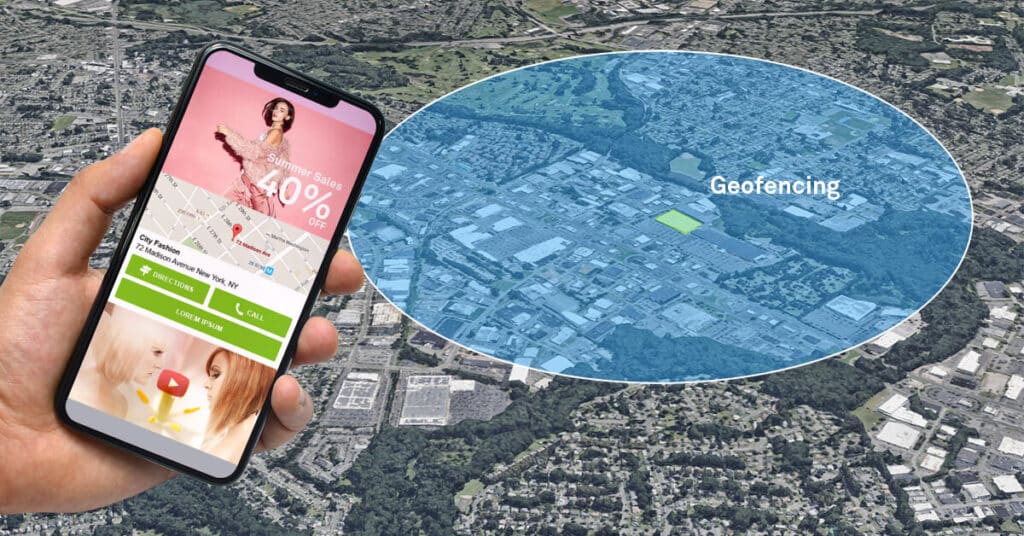Geotargeting (also called geotargeted advertising) is a type of advertising that uses location data to reach consumers with messaging appropriate to their locality and behavior.
This advertising technology displays content based on an automated or assumed knowledge of consumers’ location. For example, a car repair shop or auto dealership might run a geotargeting advertising campaign to show a certain ad to people who are within 10 miles of the shop’s location.
Geotargeting advertising is even more specific. When consumers opt in to location services for apps on their phone (such as a retail or restaurant app), geotargeting advertising lets you show ads based on their actual location. For example, if you run a quick service restaurant or clothing store, you can show ads to target consumers who are close to the premises, and encourage them to visit.
In a nutshell, geotargeting helps advertisers create more relevant, targeted promotions for consumers, resulting in increased engagement.

Start attracting new customers!
Fill out a form to connect with a marketing strategist.
Wondering how geotargeting software works? First, it detects users’ location. This is either specific, using GPS, or slightly broader, using cell towers. Second, the software or app uses this information to decide what information to show those users.
There are two main ways to geotarget consumers. The first, mentioned earlier, is via a geotargeting app. This is any app that uses location-based marketing.
For example, when you sign into a food delivery app, you’ll see options that are close to your location. And when you search for “dentists near me” in your maps app, the results are an example of geotargeting in action.
You can also use geotargeting software to better reach your target audience. For example, GroundTruth offers geotargeting advertising services, which include three important targeting tools. These are audience targeting, location targeting, and weather targeting.
Fox’s audience targeting technology helps you to:
Geotargeting advertising also relies on location targeting. This gives additional insight into how customers behave in particular localities. Here’s what’s included in Fox’s location targeting service:
Then there’s weather targeting. Weather affects customer behavior – you don’t buy umbrellas when it’s sunny out, do you? Use GroundTruth’s weather targeting to show promotions that match the audience, the location, AND the prevailing conditions.
You can use audience targeting, location targeting, and weather targeting to run many types of geotargeting advertising promotions. GroundTruth’s data shows that in-app ads are particularly effective, but you can also use mobile push notifications, SMS messages and display ads on digital billboards.
There are several reasons why it makes sense to incorporate geotargeting into your marketing strategy.
First, the potential audience is huge. In the US alone, 81% of people own a smartphone, and the percentage is even higher for young consumers. In the millennial demographic, 94% own a smartphone, and spend more time using those devices than they do watching television.
Research from MarTech Series reveals that 83% of marketers find their campaigns are more successful when they use location data. In addition:
Wondering how to use geotargeting as part of your marketing strategy? Here are some geotargeting examples where customers saw excellent benefits.
Ulta Beauty used geotargeting to boost the effectiveness of new store openings. The beauty retailer leveraged Location Audiences and Behavioral Audiences to reach potential customers who were near competitor stores and would be most interested in learning about new stores. Stores supported with GroundTruth’s location insights outperformed the others, reaching their weekly visitation targets 43% faster than other stores.
Toyota leveraged GroundTruth’s Neighborhood and Location Audience data to identify audiences most likely to shop for a new car, and to encourage them to visit nearby auto dealerships. The campaign resulted in 1,200 visits to specific dealerships, and additional visits to smaller dealerships not targeted in the geotargeting advertising campaign.
Warrior Sports used Visit Optimization and behavioral audience targeting to allocate media spend to tactics that were driving visitation. The company was able to reach and engage an audience of fitness enthusiasts. The month-long campaign drove 33% more visits to specific retail locations than the previous campaign approach.
Are you attracting new customers?